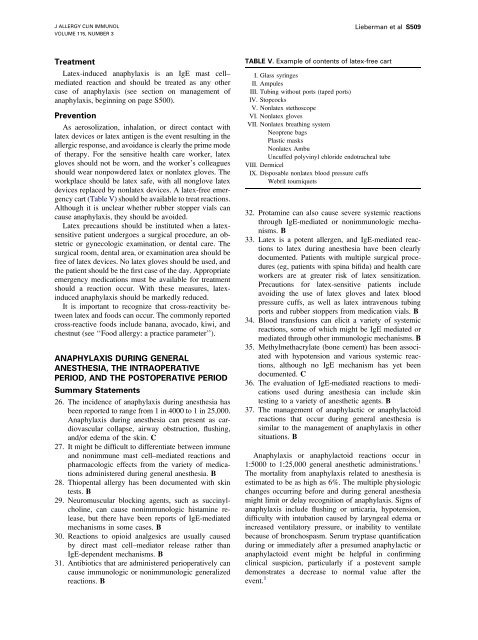Immunotherapy Safety for the Primary Care ... - U.S. Coast Guard
Immunotherapy Safety for the Primary Care ... - U.S. Coast Guard
Immunotherapy Safety for the Primary Care ... - U.S. Coast Guard
Create successful ePaper yourself
Turn your PDF publications into a flip-book with our unique Google optimized e-Paper software.
J ALLERGY CLIN IMMUNOL<br />
VOLUME 115, NUMBER 3<br />
Lieberman et al S509<br />
Treatment<br />
Latex-induced anaphylaxis is an IgE mast cell–<br />
mediated reaction and should be treated as any o<strong>the</strong>r<br />
case of anaphylaxis (see section on management of<br />
anaphylaxis, beginning on page S500).<br />
Prevention<br />
As aerosolization, inhalation, or direct contact with<br />
latex devices or latex antigen is <strong>the</strong> event resulting in <strong>the</strong><br />
allergic response, and avoidance is clearly <strong>the</strong> prime mode<br />
of <strong>the</strong>rapy. For <strong>the</strong> sensitive health care worker, latex<br />
gloves should not be worn, and <strong>the</strong> worker’s colleagues<br />
should wear nonpowdered latex or nonlatex gloves. The<br />
workplace should be latex safe, with all nonglove latex<br />
devices replaced by nonlatex devices. A latex-free emergency<br />
cart (Table V) should be available to treat reactions.<br />
Although it is unclear whe<strong>the</strong>r rubber stopper vials can<br />
cause anaphylaxis, <strong>the</strong>y should be avoided.<br />
Latex precautions should be instituted when a latexsensitive<br />
patient undergoes a surgical procedure, an obstetric<br />
or gynecologic examination, or dental care. The<br />
surgical room, dental area, or examination area should be<br />
free of latex devices. No latex gloves should be used, and<br />
<strong>the</strong> patient should be <strong>the</strong> first case of <strong>the</strong> day. Appropriate<br />
emergency medications must be available <strong>for</strong> treatment<br />
should a reaction occur. With <strong>the</strong>se measures, latexinduced<br />
anaphylaxis should be markedly reduced.<br />
It is important to recognize that cross-reactivity between<br />
latex and foods can occur. The commonly reported<br />
cross-reactive foods include banana, avocado, kiwi, and<br />
chestnut (see ‘‘Food allergy: a practice parameter’’).<br />
ANAPHYLAXIS DURING GENERAL<br />
ANESTHESIA, THE INTRAOPERATIVE<br />
PERIOD, AND THE POSTOPERATIVE PERIOD<br />
Summary Statements<br />
26. The incidence of anaphylaxis during anes<strong>the</strong>sia has<br />
been reported to range from 1 in 4000 to 1 in 25,000.<br />
Anaphylaxis during anes<strong>the</strong>sia can present as cardiovascular<br />
collapse, airway obstruction, flushing,<br />
and/or edema of <strong>the</strong> skin. C<br />
27. It might be difficult to differentiate between immune<br />
and nonimmune mast cell–mediated reactions and<br />
pharmacologic effects from <strong>the</strong> variety of medications<br />
administered during general anes<strong>the</strong>sia. B<br />
28. Thiopental allergy has been documented with skin<br />
tests. B<br />
29. Neuromuscular blocking agents, such as succinylcholine,<br />
can cause nonimmunologic histamine release,<br />
but <strong>the</strong>re have been reports of IgE-mediated<br />
mechanisms in some cases. B<br />
30. Reactions to opioid analgesics are usually caused<br />
by direct mast cell–mediator release ra<strong>the</strong>r than<br />
IgE-dependent mechanisms. B<br />
31. Antibiotics that are administered perioperatively can<br />
cause immunologic or nonimmunologic generalized<br />
reactions. B<br />
TABLE V. Example of contents of latex-free cart<br />
I. Glass syringes<br />
II. Ampules<br />
III. Tubing without ports (taped ports)<br />
IV. Stopcocks<br />
V. Nonlatex stethoscope<br />
VI. Nonlatex gloves<br />
VII. Nonlatex breathing system<br />
Neoprene bags<br />
Plastic masks<br />
Nonlatex Ambu<br />
Uncuffed polyvinyl chloride endotracheal tube<br />
VIII. Dermicel<br />
IX. Disposable nonlatex blood pressure cuffs<br />
Webril tourniquets<br />
32. Protamine can also cause severe systemic reactions<br />
through IgE-mediated or nonimmunologic mechanisms.<br />
B<br />
33. Latex is a potent allergen, and IgE-mediated reactions<br />
to latex during anes<strong>the</strong>sia have been clearly<br />
documented. Patients with multiple surgical procedures<br />
(eg, patients with spina bifida) and health care<br />
workers are at greater risk of latex sensitization.<br />
Precautions <strong>for</strong> latex-sensitive patients include<br />
avoiding <strong>the</strong> use of latex gloves and latex blood<br />
pressure cuffs, as well as latex intravenous tubing<br />
ports and rubber stoppers from medication vials. B<br />
34. Blood transfusions can elicit a variety of systemic<br />
reactions, some of which might be IgE mediated or<br />
mediated through o<strong>the</strong>r immunologic mechanisms. B<br />
35. Methylmethacrylate (bone cement) has been associated<br />
with hypotension and various systemic reactions,<br />
although no IgE mechanism has yet been<br />
documented. C<br />
36. The evaluation of IgE-mediated reactions to medications<br />
used during anes<strong>the</strong>sia can include skin<br />
testing to a variety of anes<strong>the</strong>tic agents. B<br />
37. The management of anaphylactic or anaphylactoid<br />
reactions that occur during general anes<strong>the</strong>sia is<br />
similar to <strong>the</strong> management of anaphylaxis in o<strong>the</strong>r<br />
situations. B<br />
Anaphylaxis or anaphylactoid reactions occur in<br />
1:5000 to 1:25,000 general anes<strong>the</strong>tic administrations. 1<br />
The mortality from anaphylaxis related to anes<strong>the</strong>sia is<br />
estimated to be as high as 6%. The multiple physiologic<br />
changes occurring be<strong>for</strong>e and during general anes<strong>the</strong>sia<br />
might limit or delay recognition of anaphylaxis. Signs of<br />
anaphylaxis include flushing or urticaria, hypotension,<br />
difficulty with intubation caused by laryngeal edema or<br />
increased ventilatory pressure, or inability to ventilate<br />
because of bronchospasm. Serum tryptase quantification<br />
during or immediately after a presumed anaphylactic or<br />
anaphylactoid event might be helpful in confirming<br />
clinical suspicion, particularly if a postevent sample<br />
demonstrates a decrease to normal value after <strong>the</strong><br />
event. 1
















